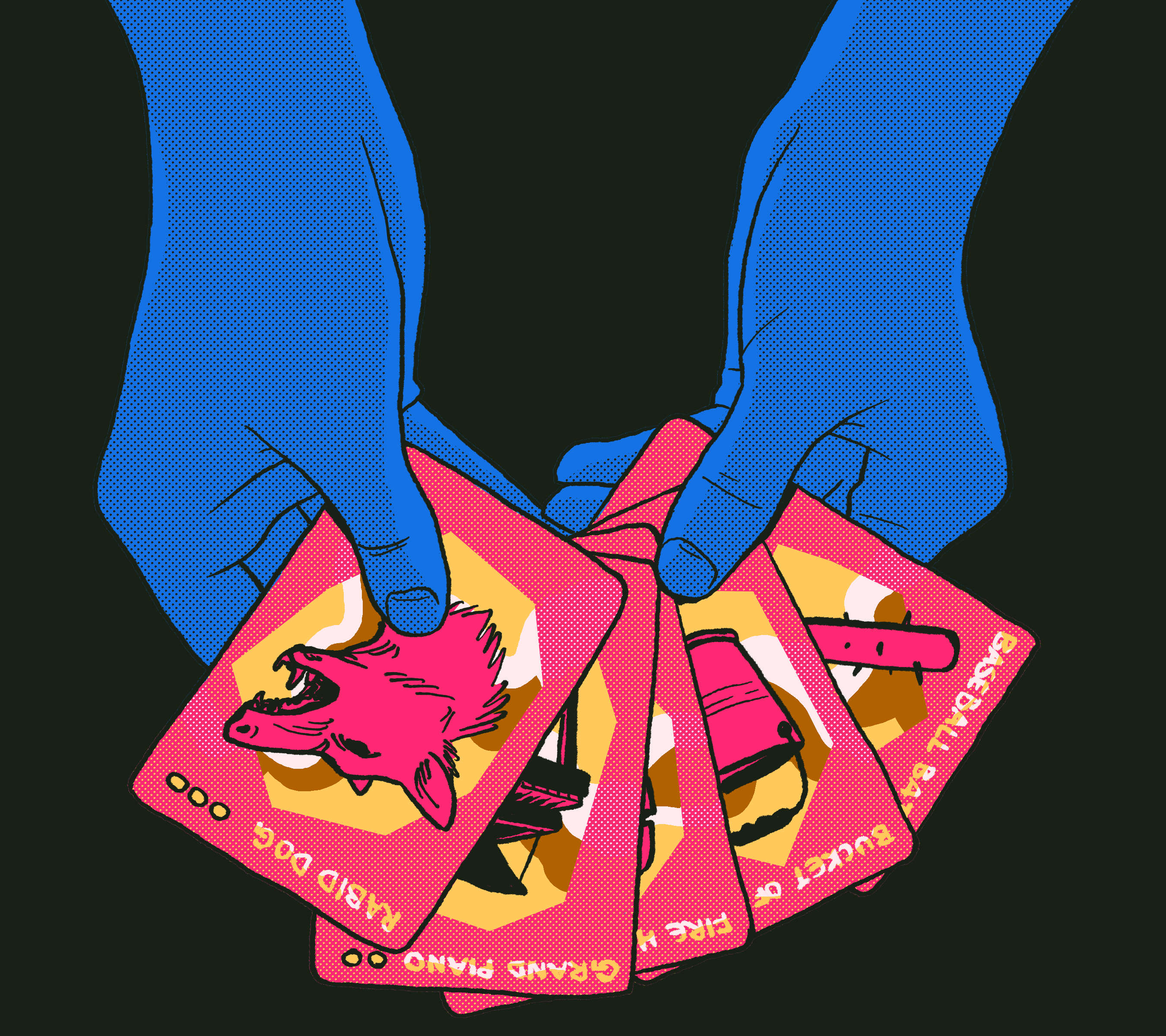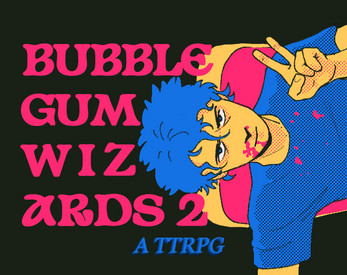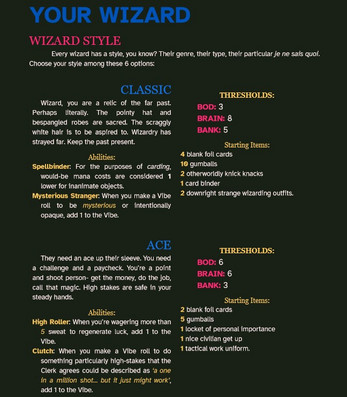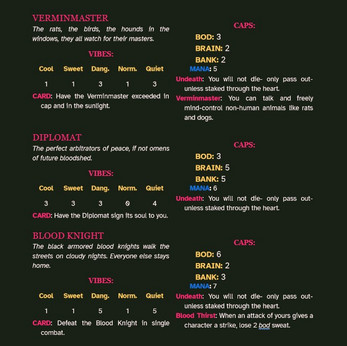
BUBBLEGUM WIZARDS: 2
A downloadable game
You're a wizard who chews bubblegum and collects trading cards. That is to say, cards with the trapped souls of items and enemies within, obviously. An insignificant wizard in an infinite city has lots to prove and you've got to get help somehow. Break heads, steal money, drive stupid, chew gum, trap souls. Simple as.
WHAT IS THIS?
This is a TTRPG, grandpa. d6s. Pencils. Paper. 2 or more people. The works. It's about urban wizards surviving in world of vampires and psychics and cultists and beasts.
Mechanically, it's a narrative-leaning 'action' game, where action doesn't necessarily mean fighting. It's built to be just as good a thriller as it is a beat-em-up. The card mechanics lend themselves to creative play and problem solving over brute force, and the dice have characters on their toes at all times.
WHAT AM I BUYING?
The rule book (22 pages), which includes:
- Narrative-focused dice mechanics, augmented by 5 Vibes (cool, sweet, dangerous, normal, and quiet) for your wizard to spec into.
- Novel sweat mechanics for sustaining damage to your body, brain, and bank account.
- A completely unique magic system with infinite possibilities for the sorts of spell cards you can collect.
- 6 strange and exciting Wizard Styles, each with their own special abilities and play styles.
- 4 simple characterizing questions to help flesh out your wizard.
- 23 varied pre-generated opponents across 4 factions, each with rules for capture as a trading card.
- A robust table for generating city neighborhoods, available free as a demo.
Also included:
- A printable character sheet, for those that prefer pen and paper.
- A google doc character sheet, that you can copy and fill out for yourself.
- A sample character sheet already filled out.

| Status | Released |
| Category | Physical game |
| Rating | Rated 5.0 out of 5 stars (10 total ratings) |
| Author | Gormengeist |
| Tags | Dice, Fantasy, Magic, rules-lite, Sci-fi, Tabletop, tabletop-role-playing-game |
Purchase
In order to download this game you must purchase it at or above the minimum price of $4.99 USD. You will get access to the following files:
FREE VERSION
Support this game at or above a special price point to receive something exclusive.
Community Copies
If for any old reason you don't want to spend the money, I give you this for free:
Download demo
Development log
- Neighborhood Generator AdditionSep 25, 2023
- Bubblegum Wizards 2- 1.6eJul 24, 2023
- Bubblegum Wizards 2- 1.5eMar 22, 2023
- First update (1.1e)Jun 18, 2022





Comments
Log in with itch.io to leave a comment.
I love this game
This absolutely rules. The idea of an endless urban sprawl of displaced people is something I want to chew on endlessly, like bubblegum, and I do wish it was slightly expanded on. However, the snappy and succinct way everything is described is also a masterstroke that I can't really argue with. When reading through a rule book gives me a solid foundation of what the world is, how to play and what it'll feel like to run the game after a single read-through, I know the game's good. For clarification, this game's fuckin great. As someone who's a sucker for magic systems, particularly more freeform ones, the system here is genuinely masterful. So full of style, and my brain is abuzz with ideas for cool characters and ways to do magic. Maybe someone who loves rare birds and so only collects cards of them, flighty and nervous who might release a flock to defend themselves...maybe someone with one card, of someone near and dear to them, using it just to hear their voice...someone with cards filled with rocks, simple and hard to beat but will Cain your ass. The vibes here are something so unique, snappy, popping and brilliant as well, slamming into your bones with such great art. I can get a sense of this world. It feels familiar. It feels otherworldly. It feels magical. It feels unique. It feels like home. If I'm fully honest, the biggest feeling I got from this game was "I am so so excited for when or if the maker of this releases Bubblegum Cultists". But that's just because I am always enchanted by the ideas presented by the sections touching on cultists. If I had one nitpicky complaint, it would be about the Vampire Lord, who must be ensnared in an "alchemical circle made of sunlight" to be Carded. Nowhere else in the book is this sort of thing brought up, and my reaction was "Oh, wait what? I guess alchemy is a thing now...? How does that work? Eh, maybe I can make it buyable or just as something in the Store, or from some NPC." It felt a bit unclear and sudden. But when my only complaint(albeit before running the game, which I certainly plan to do. Funnily enough it made me more excited to GM that to play, just cause I wanna sink my teeth into this whole world so bad.) is a single line on monster entry, I'd say that's the mark of a pretty amazing game. Thanks for making this.
I can't stop looking at the illustration of the fucko missing a glasses lens getting a gun an knife shoved in their face. The vibes of this game are immaculate.
Bubblegum Wizards is a vibrant and surreal urban fantasy that I think might be closest in genre to something like Earthbound or Yakuza Like A Dragon or maybe Seinfeld---although it clearly walks its own path.
The PDF is 23 pages, rad, dipped in colors that work in perfect counterpoint, a lite brite of rules text and gorgeous vibesy illustrations.
Lore-wise, you are a wizard and you live in the city that all cities became. You get your mana and spells from a lingering piece of the non-city world called the Corner Store, which sells them as bubble gum and trading cards. You use them to fight vampires.
It's rare to see a game concept swing this wildly, and it's beautiful when the bat makes contact with the pitch. The setting WORKS. It taps into some sort of primal nostalgia while also giving you creative room to freewheel and get weird---as long as you can do it with a straight face.
Imagine, like, a citypop version of Tsutomu Nihei's Blame! or Daniel Polansky's A City Dreaming. That's what this is.
Mechanically, Bubblegum Wizards is on the cusp between lightweight and medium weight. Think Blades In The Dark.
You have Vibes, which are skills you roll, and you also have Thresholds, which determine how much sweat (damage) you can take phyiscally, mentally, or socially before you start rolling to see if you take serious consequences. You also have Luck, which you can use to soak damage and manipulate dice, and which you gain by gambling hp on difficult rolls.
In addition to these stats, you have gumballs and foil cards, which you can take social damage to purchase from the Corner Store. Cards can be tapped against objects or creatures to permanently take on their power. Bubblegum is spent to trigger card effects.
The costs and effects of cards are loosely handled by the GM, so this is definitely a design-while-you-play-it kind of game---but in an engaging and fun way, similar to the Jojo's ttrpg.
Character creation involves picking a class, which comes with a starting package of items, but a lot of what you *do* as a character involves what you choose to card and how you manage your luck levels, so your class choice doesn't really lock you into a playstyle. Advancement is minimal, and only boosts your stats and thresholds by small amounts at the end of major arcs.
For GMs, advice is given on running the game, and there's a bestiary, but a lot of what you're doing is introducing plot beats, ticking clocks, and giving the players lots of fires to put out. If you prefer simulationist style play, Bubblegum Wizards might not click with you---it's a narratives and currencies game all the way through.
Overall, this is one of the best rpgs I've read lately. I say that a lot, about a lot of games, but that's because a lot of games are good. Bubblegum Wizards in particular is good at presenting a wonderful, intuitive setting, mechanics that perfectly match its style, and a neat little engine that rewards freewheeling and design-on-the-fly. If anything I've said here sounds good, absolutely get it.
Minor Issues:
-By raw, I think you can cheese Luck, using it to reroll dice on wagers and negate the sweat gain from failed wagers. The GM can immediately put a stop to this, but if they don't clock the issue in time it could be disruptive.
I have completed a short campaign and I have some feedback, critique, and suggestions
This game's strongest point is it's style. It's absolutely BRIMMING with it, but I think the mechanics fall short of selling the fantasy of being a cool card wizard. The limitations of magic to capturing and summoning entire objects in a card limits the available creativity and the fantasy of being a 'wizard'. I think this is actually fairly easy to fix with some small but potent changes.
Starting Cards
The first thing we noticed felt a little weird was that character creation only gives you blank cards to start with. It seems like if you’ve been a wizard for a while, you might have a few objects or creatures already carded within reason. I gave all of my players one object card to start with, and they felt like it did a lot to flesh out their characters.
Expanded Luck Usage
My first suggestion is to expand the scope of Luck. In addition to being able to use Luck to cancel Sweat, it should be usable for Rerolls and Story Manipulation.
Rerolls: Reroll all dice and use the new result.
Change the Story: Add an element to the story to make things easier. "The mechanic left their tools outside the garage" if your players need some tools. "The crime boss left one of the windows unlocked" if the players need a way in somewhere. Very versatile.
Your 1.5 update reduced the amount of luck to make players 'less invincible', but if you give them something more to do with luck, they'll spend it on more. I implemented Luck as Reroll and plot adjustment in session 1 and my players immediately started using it for that purpose.
Expanded Summoning
My second suggestion is to expand the usability of cards. Being able to summon and unsummon things has potential, but it is limiting and falls short of feeling like 'magic'. Instead, I propose that players should be able to summon aspects of the carded thing.
For instance, if I have a Fan, instead of summoning the entire fan, I can blow a gust of wind. If I have an Armadillo, instead of summoning the armadillo, I can summon its Armor to make an ally more durable. If I have a Blood Knight, instead of summoning the entire knight, I can just summon its radical sword. Etc. This opens the door for more creative thinking, and also the creation of 'spells' that give an individual a more developed 'style'.
More Guidance
The game's mechanics are simple and robust, but I feel like they need more examples for how things might or should play out.
I come from Dungeons and Dragons, and other comparatively rules-heavy systems, so the extremely lightweight rules leave me wanting more examples for how things should work.
I decided to give each of my players one card to start with, and one of my players chose a Stop Sign that he could use as a weapon, but I wasn't sure what a stop sign would do for him. Should an attack with the stop sign do more Sweat than a fist? It's intuitive that it should work that way, but I'm a dummy that needs guidance, and I think others would benefit from it as well.
I would also personally appreciate some guidance for how you would ideally handle a turn structure if the need arose. Ultimately my biggest critique and desire is for more examples of how things might work and how to utilize the simple rules to the best effect.
In Conclusion
My little wizards were press ganged into cleaning the psychics out of a rat king's sewer lair. He threatened to eat one of them if they laid a hand on his babies (4 regular turtles). They ended up parleying with the psychics and offering to find them a new hideout, which took them through the vampire-run metro, a blasted demon wasteland, and finally to a chill fantasy district where they fought to the death with a Negotiator who was trying to reaquire the espers for the corporation that had made and lost them.
We had a lot of fun with the system, but struggled with getting our heads around the more cinematic nature of the system, and believe that these changes (especially the additional examples and guidance) would make it more fun, and a little easier for other people in our situation to make the jump.
Addendum
One of my players helped me slap together a Roll20 character sheet for Bubblegum Wizards 2, and I'd love to pass you the code if you're itnerested.
First of all, I'm just delighted to receive such a robust and thoughtful comment. Demonskunk 4ever. Putting in the work to make this system work for you even though it wasn't all there on the page how you wanted is not an ideal play experience, and it's tough(!) so I'm very grateful for you doing it and taking the time to tell me.
I will implement these changes or ones to that effect immediately! Thank you again, and I'm really pleased you had fun with this system.
PS. I would be interested in that Roll20 sheet. I will be in touch if I end up using it for anything for crediting purposes.
I'm extremely relieved at your response, I was super worried I'd come across as mean ;u;
I feel a degree of solidarity with you, as a fellow indy game writer, and you've been really cool in replies, so I figured the least I could do was give honest feedback! I'm looking forward to seeing the revisions when they come!
The character sheet code is below.
If you're not familiar with how to do custom sheets, you choose "Custom" on the character sheet when you're making a new game, then click "Settings" on the game launch page, then "Game Settings" and paste the HTML Layout code into the black box at the bottom of the page, then the CSS Styling under the CSS Styling box.
HTML Layout
<c><div> <div class="center"><h1>Gumball Wizards II</h1></div> <b>Name:</b> <input type="text" name="attr_char_name" /> <b>Wizard Style:</b> <input type="text" name="attr_char_style" /> <b>Level:</b> <input type="number" name="attr_char_level" size=1 /> <br> <hr> <table> <tr> <td> <h3><center>Vibes</center></h3> <table> <tr> <td><b>COOL:</b></td> <td><input type="number" name="attr_cool_current" /></td> <td></td><button type='roll' value='[[2d6+@{attr_cool_current}]]' name'roll_cool'>ROLL COOL</button><br></td> </tr> <tr> <td><b>SWEET:</b></td> <td><input type="number" name="attr_sweet_current" /></td> </tr> <tr> <td><b>DANGEROUS:</b></td> <td><input type="number" name="attr_danger_current" /></td> </tr> <tr> <td><b>NORMAL:</b></td> <td><input type="number" name="attr_normal_current" /></td> </tr> <tr> <td><b>QUIET:</b></td> <td><input type="number" name="attr_quiet_current" /></td> </tr> </table> </td> <td width=50> </td> <td> <h3><center>Sweat</center></h3> <table> <tr> <td><b>BOD:</b></td> <td><input type="number" name="attr_bod_current" size=1 /></td> <td>/</td> <td><input type="number" name="attr_bod_max" size=1 /></td> <td><b>STRIKES:</b> <input type="number" name="attr_bod_strikes" size=1 /></td> </tr> <tr> <td><b>BRAIN:</b></td> <td><input type="number" name="attr_brain_current" size=1 /></td> <td>/</td> <td><input type="number" name="attr_brain_max" size=1 /></td> <td><b>STRIKES:</b> <input type="number" name="attr_brain_strikes" size=1 /></td> </tr> <tr> <td><b>BANK:</b></td> <td><input type="number" name="attr_bank_current" size=1 /></td> <td>/</td> <td><input type="number" name="attr_bank_max" size=1 /></td> <td><b>STRIKES:</b> <input type="number" name="attr_bank_strikes" size=1 /></td> </tr> <tr> <td><b>LUCK:</b></td> <td><input type="number" name="attr_luck_current" size=1 /></td> <td>/</td> <td><input type="number" name="attr_luck_max" size=1 /></td> </tr> <tr><td> </td></tr> </table> </td> </tr> </table> <hr> <h3>ABILITIES</h3> <input type="text" name="attr_ability_1_name"><br> <textarea name="attr_ability_1_text" rows="2" cols="50">Placeholder</textarea><br><br> <input type="text" name="attr_ability_2_name" /><br> <textarea name="attr_ability_2_text" rows="2" cols="50">Placeholder</textarea><br><br> <input type="text" name="attr_ability_3_name" /><br> <textarea name="attr_ability_3_text" rows="2" cols="50">Placeholder</textarea><br> <hr> <h3>INVENTORY</h3> <textarea name="attr_inventory" rows="2" cols="50">Inventory...</textarea><br> <hr> <h3>SPELLS</h3> <textarea name="attr_spells" rows="2" cols="50">Spell Cards...</textarea><br> <hr> <h3>BACKGROUND</h3> <textarea name="attr_origin" rows="2" cols="50">I came from...</textarea><br><br> <textarea name="attr_wizard_roots" rows="2" cols="50">I became a wizard when...</textarea><br><br> <textarea name="attr_got_to_lose" rows="2" cols="50">I have...</textarea><br> </div> </c>CSS Styling.charsheet { background: #1b2117; } div { color:#ffffff; font-family:"arial"; margin: auto; padding: 10px; } .charsheet center { margin: auto; width: 100%; border: 3px solid green; padding: 10px; } .magenta { color:#e94174; } .yellow { color:#f6cb6e; } textarea { color:#ffffff; background: #1b2117; !important } input { color:#ffffff; background: #1b2117; !important } table { margin: auto; padding:; 10px; width: 80%; } h3 { color:#ffffff; width: 100%; margin: auto; } h1 { color:#ffffff; width: 100%; margin: auto; }Reading through the book, I just noticed that the Hot Shot Esper's description is copied from the Scanner.
Thank you for letting me know! In Bubblegum Wizards 2 (1.2e), there is one change: Hot Shot Esper has a unique description.
Rad! I'm eager top try this game out. I love the flavor, and the minimal 3-color book layout is really evocative and cool.
I only have two questions:
1: Is there a bubblegum wizards 1?
2: Are you planning on writing Vampire, Cultist and Psychic games to go with this one?
Thank you!
1: There is a Bubblegum Wizards 1, though I see it as a strictly worse version of this one, so it's free. It's the first thing I published on itch and I keep it up mostly for posterity.
2: When I released this, I super did, though now that's not a specific plan on the horizon because I've just released a larger project that I intend on supplementing. But you asking this question has sharply raised the possibility.
Beautifully written and designed. The rules are easily understood and catch the eye!! Perfect for ADHD freaks like me. I love the aesthetic of it all. I highly suggest you check this and Psychhopunk out. Gormengeist is an awesome game designer.